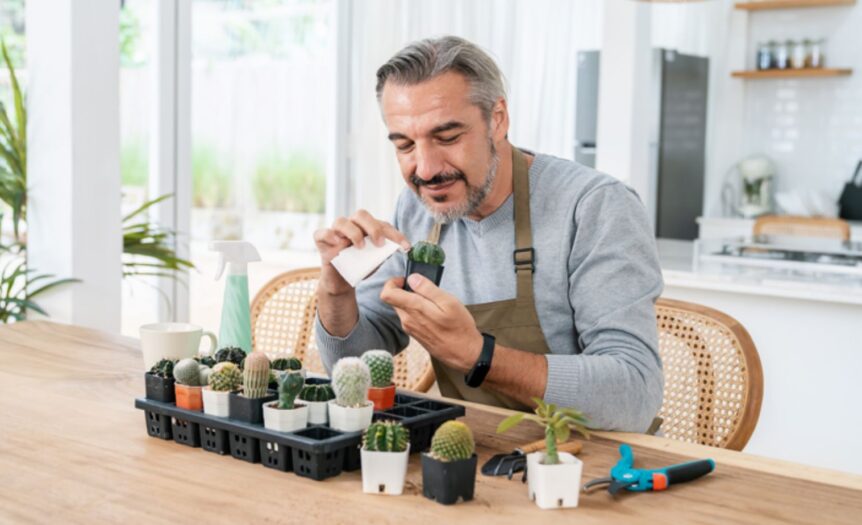If you’ve ever gazed at a cactus or succulent and wondered, “Could I grow that?” – you’re in the right place! I’m here to unravel the mystery of these fascinating, resilient plants, and guide you through a simple 6-step process to grow your own.
Cacti and succulents are more than just trendy Instagram stars. They’re hardy, low-maintenance, and offer a unique aesthetic that can transform any space. But how do you go from cactus admirer to cactus grower? Let’s embark on this green-thumb journey together.
1. Choose The Plant
Picking the right plant holds paramount importance in the journey of cultivating cacti and succulents. Strip away any apprehensions about diversity and choices. Remember, it’s my start, my choice.
With a plethora of options available, I’ll focus on the key factors affecting my decision – hardiness, size, and visual appeal. Hardiness indicates a plant’s resilience, especially if I’m a beginner at this. Size matter, since the plant should adapt well to my available space. Yet, visual appeal remains a matter of personal preference.
2. Select The Right Soil Mix
For a flourishing cactus or succulent plant, the selection of an appropriate soil mix plays a vital role. Unlike common houseplants, these unique species prefer a well-draining, coarse soil mixture for optimal growth.
In a quest for the ideal soil, I’ve discovered that commercial cacti or succulent mixes available on online stores such as cactusoutlet.com yield top-notch results. By providing adequate drainage and aeration, these mixes prevent roots from sitting in water for too long, which can lead to rot.
3. Perfect The Potting Process
Mastering the potting process, I found, plays a crucial role in nurturing sturdy, healthy cacti and succulents — acting as a bedrock for effective watering, pruning, and overall growth.
Selecting the Right Pot
Initially, determine an appropriate pot for your cacti or succulent. Heavy pots made of clay or ceramic offer a stable base for these top-heavy plants. They also allow for better evaporation, a boon when one’s trying to prevent waterlogged roots.
Deciding on Drainage
Next, ensure your chosen pot has adequate drainage holes.

If left stagnant, excess water proves detrimental to the roots of these desert dwellers, potentially leading to root rot. Sites like cactusoutlet.com offer a wide variety of pots equipped with ample drainage, ideal for these plants.
Mastering the Planting Depth
As for the planting depth, the crown of the plant — where the stem meets the roots — should rest at the soil’s surface. Burying it too deep risks suffocation, while placing it too high might lead to instability and poor growth.
4. Master The Watering Routine
Step four on our journey to becoming cactus and succulent gurus leans on mastering the Watering routine. The rule of thumb in the watering routine for these plants, whether it’s the hardy Sansevieria or the visually appealing Aeonium ‘Sunburst,’ is moderation.
Cacti and succulents naturally thrive in dry, arid conditions. They’ve adapted to store water in their leaves, stems, and roots, making it possible for them to survive long periods without water. Overwatering, contrary to what one might think, can do more harm than good. It often leads to root rot, a sure death sentence for most plants.
Determining when to water isn’t as challenging as it may seem. Firstly, always check your plant’s soil before reaching for the watering can. If you find a dry, crumbly texture in your coarse soil mix after poking a finger an inch into it, it’s time to water.
Always water your plants thoroughly until you see water flowing out of the pot’s drainage hole, emulating a good, hefty rain. Then, let the plant sit and drain completely. You’ll want to ensure there’s no water collected in the saucer under your pot. Pooling water can lead to the dreaded root rot condition.
5. Pruning and Propagation
Having earlier delved into mastering the watering routine for cacti and succulents, let’s now shift focus to two crucial elements in their care – pruning and propagation.
Pruning Cacti and Succulents
Don’t hesitate to get those pruning shears out. Pruning, far from being a destructive process, is a constructive act. For cacti and succulents, in particular, it serves a threefold purpose: promoting healthier growth, shaping the plant, and controlling its size.
First, when pruning off unhealthy parts of the plant – be it dead or diseased segments, it promotes newer, healthier growth. Second, by selectively trimming your cacti or succulents, you’re given the control of sculpting the plant, molding its form, and creating an aesthetic that suits your preference. Lastly, it allows you to manage the size of your plant, especially if you’re considering space constraints.
Propagation of Cacti and Succulents
Propagation, in simple terms, is a method by which new plants are grown. For such resilient species as cacti and succulents, there are usually three methods: through seeds, leaf cuttings, or offsets (small baby plants sprouting from the base of an adult plant).
Seeds, while often the slowest method, can offer a large quantity of new plants. Patience, specialized soil, and correct light conditions are prerequisites. Alternatively, leaf cuttings provide a quicker and less complex way, with fewer requirements. Lastly, using offsets is arguably the easiest way to propagate. Once removed from the parent plant, they can be left to dry for a few days before planting them in a well-drained soil mix.
Remember, propagation isn’t an instant process and requires patience. As an added tip, once you’ve successfully propagated, consider revisiting online resources like cactusoutlet.com for post-propagation care.
6. Protect Against Pests And Diseases
After mastering the skills of watering, pruning, and propagation, it’s crucial to focus on safeguarding your vibrant cacti and lush succulents from harmful pests and diseases.

I’ll guide you on how to efficiently prevent, identify, and treat common botanical pesky nuisances and plant ailments.
Identifying Issues
To stay proactive in your plant care regime, you’ve to regularly monitor your plants for early signs of infestation or disease. Indications often include discolored or shriveled leaves, unexpected plant wilting, a substance that resembles cotton wool, or small distortions or holes in the plant. In case of any abnormalities, a reputed resource like cactusoutlet.com can provide guidance to help identify the issue.
Preventive Measures
Prevention is, unequivocally, the best pest management strategy. Pests favor weak or stressed plants, hence maintaining robust plant health decreases the likelihood of infestation. Assuring good watering and pruning practices alongside providing balanced nutrition and ample sunlight safeguards the plants. Quarantine newly bought plants for around two weeks before introducing them to your existing plant family, ensuring they don’t bring any unwanted guests with them.
Remember, defense against pests and diseases is a vital part of nurturing thriving cacti and succulents. Double down on your preventive measures, and when pest or disease symptoms arise, act swiftly. Don’t hesitate to seek assistance from reputable sources like cactusoutlet.com for additional guidance. The captivating journey of cacti and succulent caregiving continues with every ailment thwarted and every pest deterred.
Conclusion
So there you have it. Nurturing cacti and succulents isn’t just about the basics like watering and pruning. It’s also about staying vigilant against pests and diseases. Remember, early detection is key, and resources like cactusoutlet.com are there to help. Don’t shy away from preventive measures to keep your plants healthy and always be ready to act fast with treatments like insecticidal soap or neem oil. In severe cases, you might even need to remove the affected plants. It’s all part of the journey to growing thriving cacti and succulents. Keep learning, keep growing, and most importantly, keep your plants healthy.








